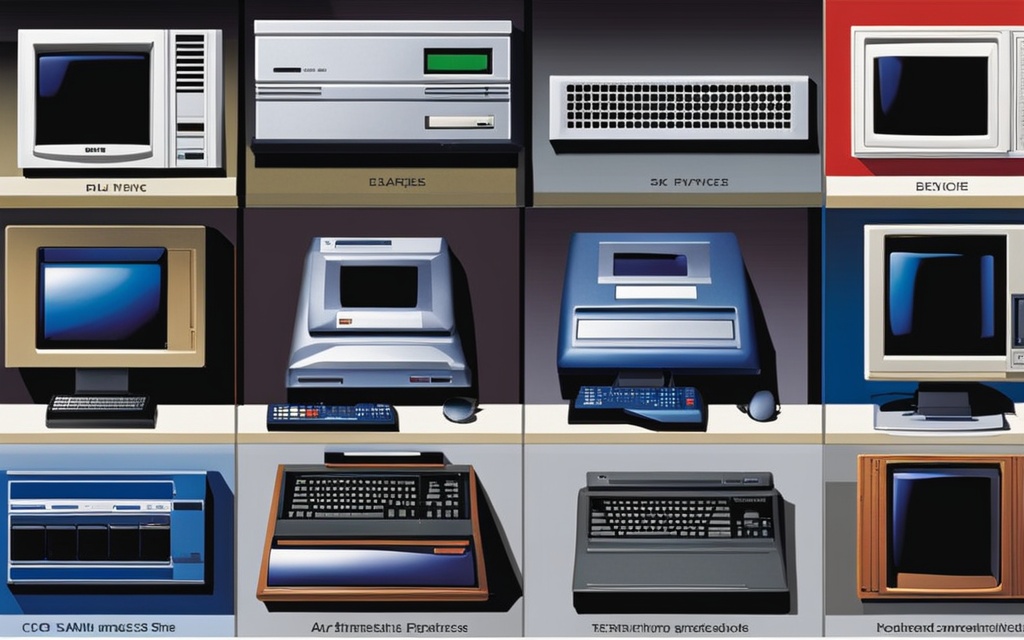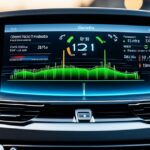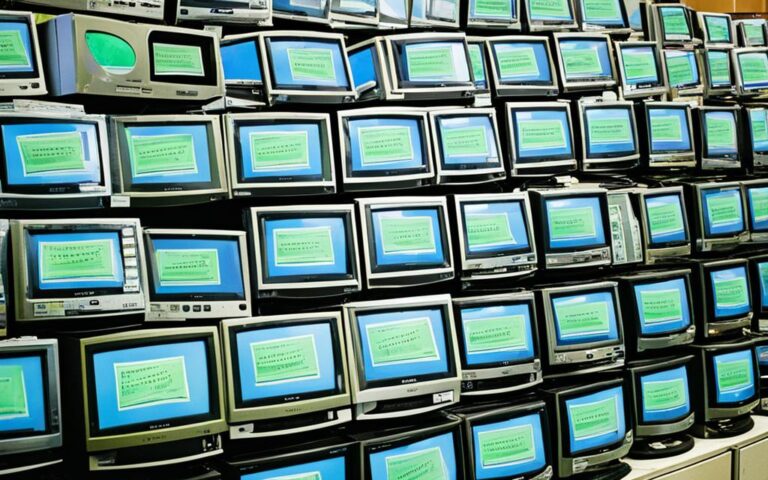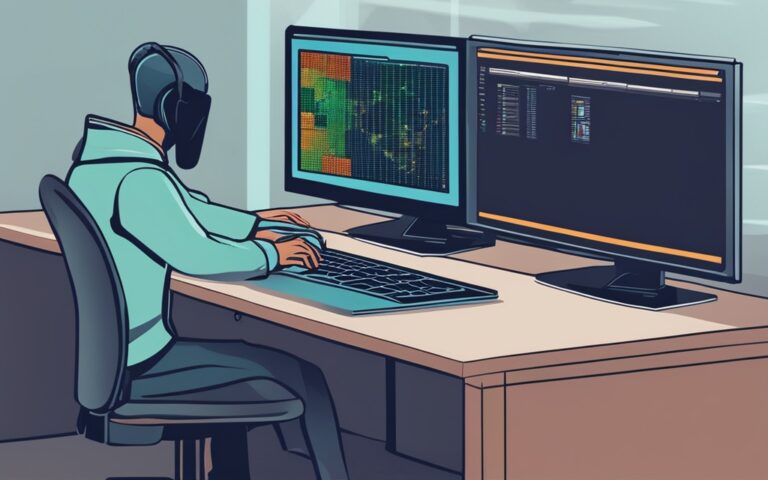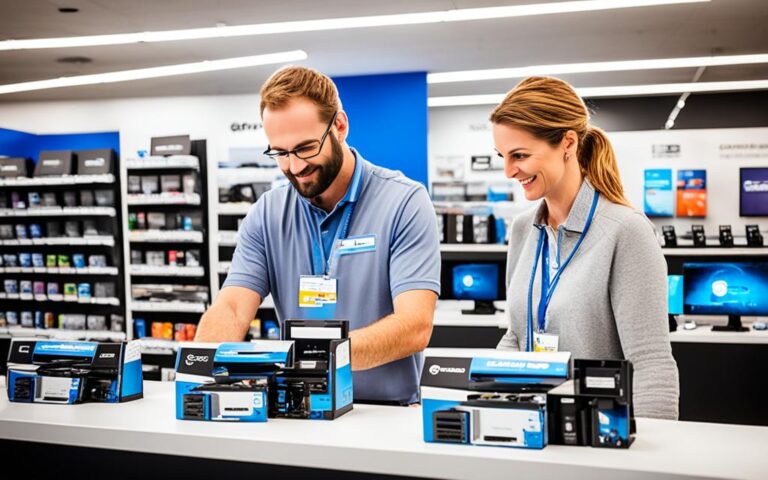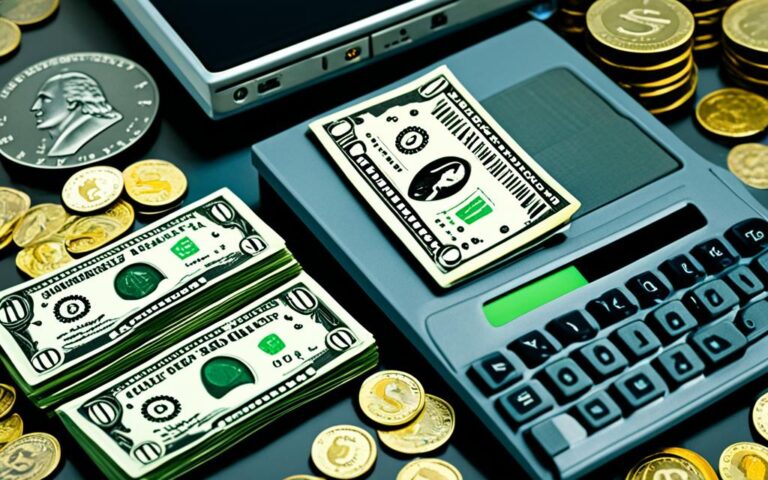In the 1990s, computers changed a lot. They got much better in several ways. We saw better microprocessors and the birth of the personal computer. Computers became more powerful, and the internet started to grow. These big steps changed how we use technology today.
Key Takeaways:
- The 1990s marked a period of major transformation for computers, with advancements in microprocessors and increased computing power.
- The introduction of the personal computer in the 1990s revolutionized the way individuals interacted with technology, making computing more accessible and user-friendly.
- The emergence of the internet in the 1990s opened up new possibilities for communication, information sharing, and global connectivity.
- Technological advancements in the 1990s, such as the rise of blogs and online platforms, contributed to increased visibility and awareness of issues like gay rights and social justice.
- The 1990s also saw the rise of popular consumer items like Beanie Babies and Pokémon trading cards, reflecting the growing influence of technology in popular culture.
1 In 1998 alone, there were about 1000 hate crimes reported against gay people. Sadly, many incidents might not have been reported. The 90s saw a rise in support for gay rights. This was thanks to more visibility on blogs and the internet.
The Evolution of Microprocessors
In the 1990s, microprocessors saw huge improvements. They changed computing forever and started a new technology era.
Intel and AMD led this change. They created microprocessors that were faster and more effective than ever.
These microprocessors could run at speeds of 200MHz or more. This power made it possible to run complex programs and do several tasks at once.
Thanks to this, we got better software, games, and graphical interfaces. The 1990s became a turning point in computing.
The Advancements
The 1990s brought quick advances in microprocessors because of several key developments:
- The Intel 4004 was the first microprocessor for sale. It had a speed of 740 kHz and could handle 4-bit data sizes2.
- In 1979, the Motorola 68000 was launched. It had a speed of 8 MHz, worked with 16/32-bit data, and had 68,000 transistors2.
- The same year saw the birth of Intel’s 8088. It worked at 5 MHz and had an 8/16-bit data size2.
- The Intel 80386 came out in 1985. It was a big moment for IBM compatible PCs moving to 32-bit systems2.
- In the 1980s, Memory Management Units (MMUs) started showing up in microprocessors. The Intel 80286 and Motorola 68030 both had this feature2.
- By the late 1980s, Floating Point Units (FPUs) were added. They first appeared in the Intel 486 and Motorola 680402.
- Reduced Instruction Set Computers (RISC) became popular, too. In the 1980s, smaller companies introduced designs that could compete with Intel and Motorola2.
These key developments boosted microprocessors to new levels. They increased computing power and set the stage for future technology.
The Impact
The 1990s’ microprocessor innovations had a huge effect. They made personal computers better and more powerful than big old computers3.
These new devices became common in the 1990s. They changed how we used computers and brought them to more people. The computing world was forever changed, with devices that could sit on a desk or later fit in a pocket3.
Microprocessors are now a key part of our everyday life. They connect us and give us access to a world of information. This shift led us into the digital age, changing how we communicate, work, and interact3.
The Advantages and Disadvantages
Microprocessors come with many benefits. They are fast, small, easy to maintain, flexible, and can be scaled up easily. They’ve pushed technology forward4. Nowadays, they also have multi-core processors, cache memory, internet connection, and are smart enough for machine learning4.
But there are downsides, too. They can get very hot and need good cooling. They might slow down with big data sizes. Compared to microcontrollers, they are bigger. And, they’re not the best at handling decimal operations4.
| Milestone | Year | Key Features |
|---|---|---|
| Intel 4004 | 1971 | Clock speed: 740 kHz Word size: 4-bit2 |
| Motorola 68000 | 1979 | Clock speed: 8 MHz Word size: 16/32-bit Transistors: 68,0002 |
| Intel 8088 | 1979 | Clock speed: 5 MHz Word size: 8/16-bit2 |
| Intel 80386 | 1985 | Introduced 32-bit architecture2 |
| Intel 486 | 1989 | Debuted floating point unit (FPU)2 |
| Motorola 68040 | 1990 | Debuted floating point unit (FPU)2 |
| Pentium | 1993 | Clock speed: 66 MHz Cache memory: 8-bit for instructions and 8-bit for data4 |
| Intel Core 2 | 2006 | Clock speed: 1.2 GHz to 3 GHz Cache memory: 64 KB L1 cache per core, 4 MB L2 cache4 |
Microprocessors have shaped our world in many ways. As they keep getting better, they promise even more changes for the future of computing.
IBM’s Introduction of the PC
In the 1990s, IBM launched the personal computer (PC), changing computers forever5. They introduced the IBM Personal Computer in 1981, which became very popular5. It was a big achievement in the computer world5. This computer was smaller, faster, and cheaper than before, thanks to the Intel 8088 chip5. It led the way in making personal computing what it is today.
The IBM PC had 16 kilobytes of memory, which could grow to 256 kilobytes5. It had up to two floppy disks for storage5. This made the IBM PC stand out and redefine what a computer could do5. It also had a hard disk and worked well with word processing, making business tasks easier5. Its small size and low cost helped it become popular at home and in small businesses.
The IBM PC did not just help IBM; it changed how we use computers in work, school, and play5. Computers became a big part of life in the 1990s, leading to lots of new tech advancements5.
The Legacy of the IBM PC
The IBM PC’s launch was a key moment for computing5. It allowed anyone to use technology, from homes to large companies. This changed society and led to the digital era we live in now5. The IBM PC started many tech trends, like the internet and home computing. Its effects are still important today, showing its lasting importance in tech history5.
| Statistical Data | Source |
|---|---|
| IBM introduced the IBM PC in 1981, selling over 500,000 units in the first two years5. | Link 2 |
| The IBM PC featured 16 kilobytes of memory, expandable to 256 kilobytes, and one or two floppy disk drives5. | Link 2 |
| Compaq, in its first year of production (1983), shipped 53,000 portable PCs generating over $111 million in revenues, the most by any first-year company in the U.S. business at that time5. | Link 2 |
The IBM PC started a computing revolution in the 1990s5. It was fast, affordable, and compatible, leading to PCs being used everywhere5. It helped create the digital world we have today.
Personal Computers: The Game-Changer
The 1990s was a big time for personal computers. They got smaller, faster, and cheaper. This change affected many parts of our lives.
In the 1990s, microprocessors got way better. Their speeds hit up to 100MHz, then 200MHz. Some even reached the gigahertz (GHz) range by the late 1990s. With faster processors, like the mid-1990s Intel Pentium, PCs could run big desktop apps. Programs like AutoCAD worked smoothly. This tech leap pushed PCs into a new era.
Windows 95 came out in the 1990s too. It was an operating system that was easy to use. It helped people and businesses use PCs better and more efficiently.
The internet and World Wide Web started to get popular in the mid-90s. They made it easy to share info worldwide. This led to online shopping and e-commerce. Companies like Amazon and Google grew big in this digital age.
IBM introduced the PC with an Intel 8088 processor in the 1980s. You could buy PCs in stores, making them available for smaller businesses and home use. This started a tech revolution. Computers weren’t just for big companies anymore. They were for everyone, creating new jobs in the computer industry.
PCs became essential for many tasks. Things like word processing, gaming, and internet browsing. The 1990s microprocessors made PCs faster, more powerful, and cheaper. This shift changed computing forever and made technology a part of our everyday life.
The 1990s were a turning point for personal computers. They pushed technology forward, connected us more, and helped the economy grow. Their effect on us and the world is huge. This time started a new computing era that influences how we live and work today.
The Availability of Computers Through Retail Channels
Computers became widely available in the 1990s thanks to retail channels. IBM’s PC and others hit department and electronics stores, making them accessible to more people. This move allowed smaller businesses and home users to buy computers easily. It also made computers cheaper, helping the industry grow.
In the 1990s, people talked about their computer’s limits, like an IBM clone with a tiny hard drive and little memory6. Windows 95 came out on many floppy disks. You’d need thousands of disks for Windows 10 today6.
Back then, network admins always had BNC terminators for the common BNC cables6. AOL’s huge mailing campaign used up 10% of the world’s CDs6.
The internet era began with slow dial-up modems, moving to faster ones6. Popular games were Doom and Lemmings. The Y2K bug scare had the IT world worried6.
Computers reached more users in the 90s due to retail sales, changing the market. This step made tech cheaper and available to regular folks and businesses6.
| Statistical Data | Description |
|---|---|
| Record PC shipments in the UK in 1989 | 1.17 million units |
| Apple’s margin slashes and partnership deals in 1992 | Margin reduced to 25% and deals with Dixons and PC World |
| IBM’s first-ever quarterly loss in the second half of 1990 | $256 million |
| Compaq’s plans for a direct operation in the UK in 1993 | Expected to establish a direct operation in the UK after launching a telesales arm in the US |
| Compaq’s announcement to double the vendor’s marketing fund in 1994 | Plans to double the vendor’s marketing fund |
More retail channels in this era boosted the computer industry’s growth and made tech widely available7. Stores like Dixons and PC World were key in selling computers to many people7.
The internet and Windows 95 began the surge of internet use in 19958. Smartphones, especially the iPhone, brought even more online. Platforms like Facebook and YouTube changed the web from personal sites to sharing hubs8.
Artificial intelligence has changed online experiences, leading to smarter, cheaper platforms8. Big firms like Facebook and Google thrive on data and algorithms, staying ahead8.
The web’s structure changed to centralized servers, altering content distribution and user interactions8. Online habits have shifted, with technology pushing content to users differently than before8.
Computers in retail shops in the 90s started the tech adoption we see now. With the internet’s rise and new tech, our digital world has transformed dramatically8.
Conclusion
The 1990s were pivotal in computer evolution, leading us into the digital age. Innovative work from the 1800s by Charles Babbage laid a foundation. The introduction of the internet and the World Wide Web drastically changed computing.
In that key decade, computers became stronger and more accessible. Microprocessors made computers smaller, cheaper, and more available to people. Personal computers changed, setting the stage for today’s technology. Online communication and e-commerce changed how we talk and do business.
These changes greatly affected society. The 1990s saw computers become widely used, sparking a global economy. They connected the world in new ways. Now, computers are crucial to our lives. They drive innovation in all fields.
Looking ahead, computing and artificial intelligence will significantly impact our future. Computers will keep changing our life, work, and how we interact. The digital age is still growing. The future holds endless possibilities for change.
FAQ
What changes did computers undergo in the 1990s?
The 1990s were a big deal for computers. They got much better microprocessors and we saw the birth of the personal computer. This time also saw computers getting faster and the internet starting up.
What advancements were made in microprocessors during the 1990s?
Microprocessors leapt forward in the ’90s, getting both faster and smarter. Intel and AMD pushed speeds up to 200MHz, maybe even more. This meant computers could run complex programs and do several things at once.
How did IBM’s introduction of the PC revolutionize the computing industry in the 1990s?
IBM’s PC launch was a game-changer in the ’90s. Their first PC was small, quick, and didn’t cost lots, bringing in loads of new users. Its hard disk drive and software for creating documents changed how businesses worked and made computers popular at home and in small companies.
How did personal computers change the landscape in the 1990s?
In the ’90s, computers entered our homes and workplaces like never before. They became essential for work, play, and creativity. IBM’s introduction of the PC started this, making computers widespread in both businesses and homes. This sparked online communication and the start of online shopping.
How did the availability of computers through retail channels contribute to their widespread adoption in the 1990s?
Getting computers in the ’90s was easier thanks to stores and computer shops. This meant businesses and people at home could now afford them. More affordable prices meant more people could join the digital age. This was a huge boost for the computer industry.
How did the developments of the 1990s shape the digital age?
The ’90s set the foundations for today’s digital world. Better microprocessors, PCs, more power, and the internet changed everything. These advancements made computers faster and brought us online shopping and global connections. The ’90s’ tech leaps continue to influence our digital life today.
Source Links
- https://www.history.com/news/90s-technology-changed-culture-internet-cellphones – The 1990s: When Technology Upended Our World | HISTORY
- https://en.wikipedia.org/wiki/Microprocessor_chronology – Microprocessor chronology
- https://www.byjusfutureschool.com/blog/how-microprocessors-have-changed-the-history-of-computing/ – How Microprocessors Have Changed the History of Computing?
- https://www.geeksforgeeks.org/evolution-of-microprocessors/ – Evolution of Microprocessors – GeeksforGeeks
- https://www.britannica.com/technology/IBM-PC – IBM PC | computer line
- https://www.healthdatamanagement.com/list/it-of-the-1990s-weve-come-a-long-way-baby – IT of the 1990s—we’ve come a long way, baby – Health Data Management
- https://www.computerweekly.com/microscope/feature/The-channel-of-the-1990s – The channel of the 1990s | Microscope
- https://www.medium.com/hackernoon/how-the-internet-turned-bad-b85b079ac45f – How the Internet Turned Bad
